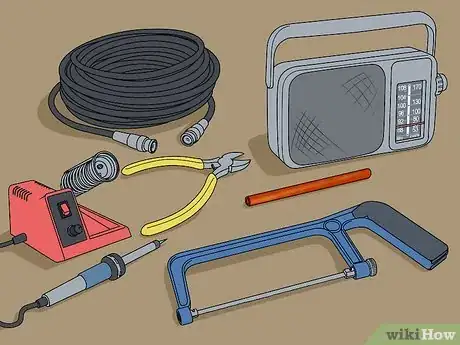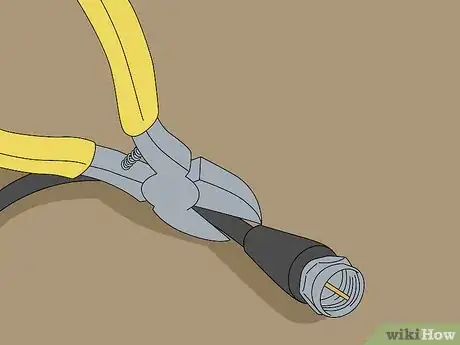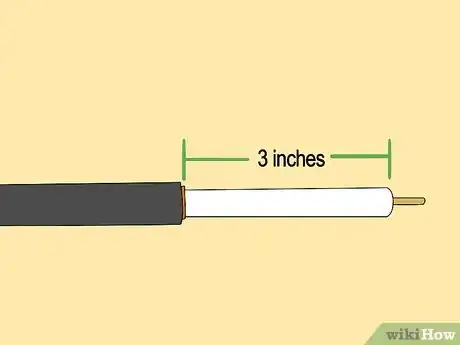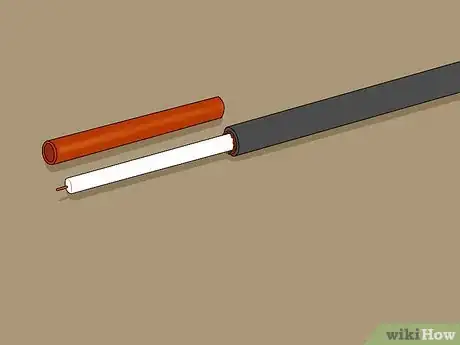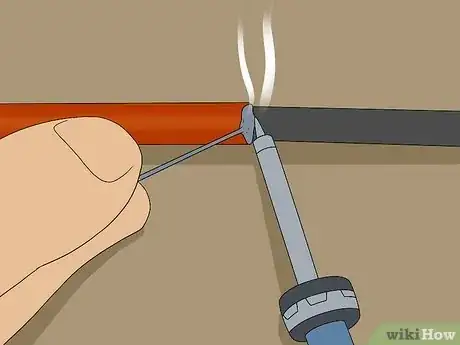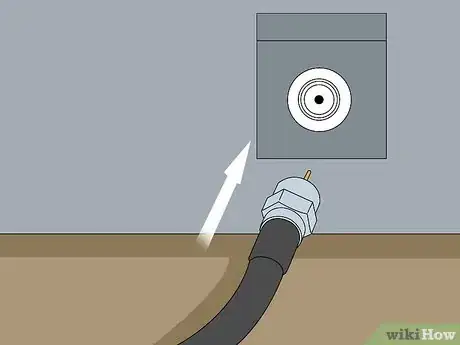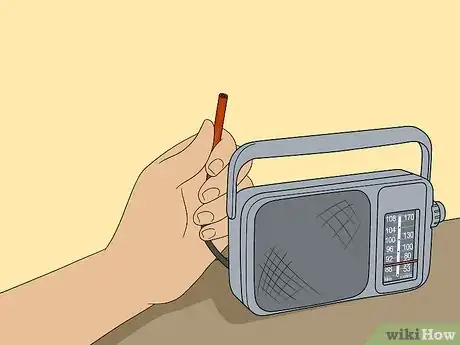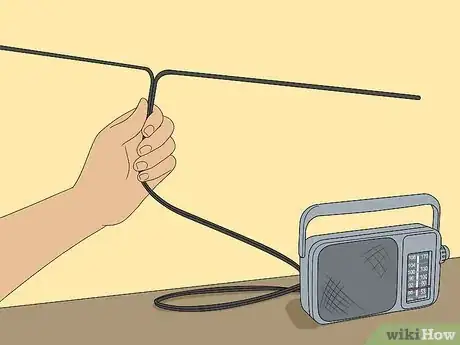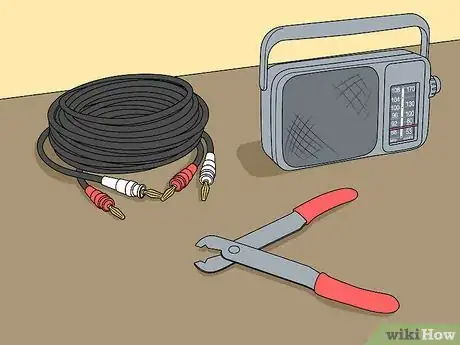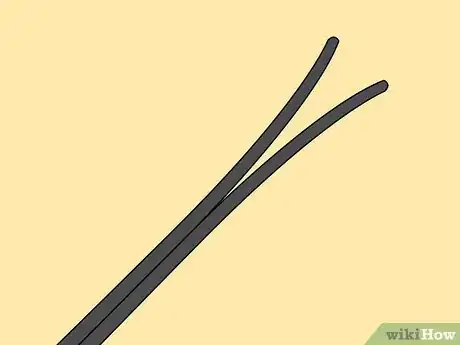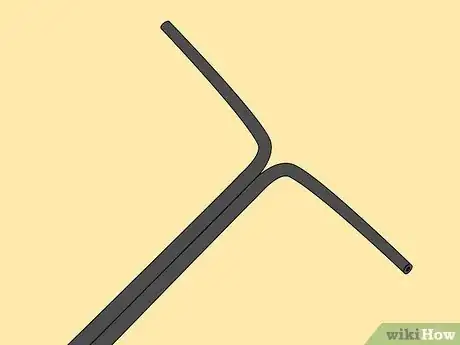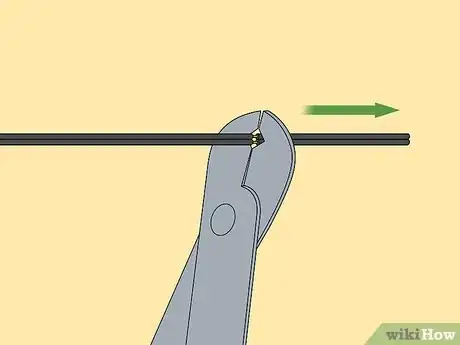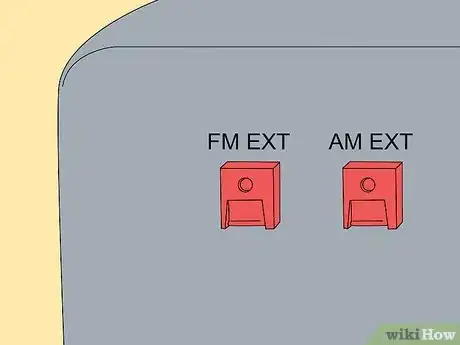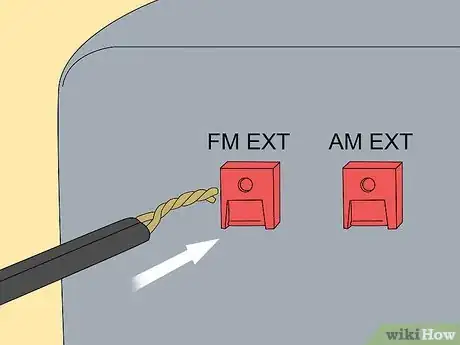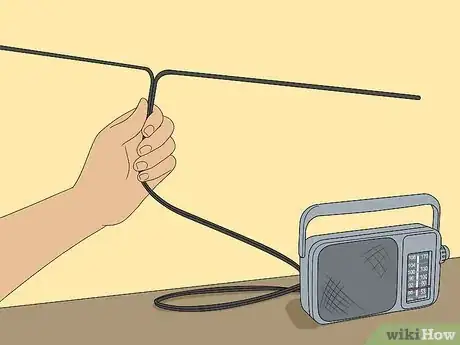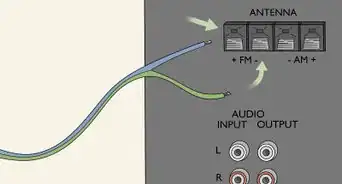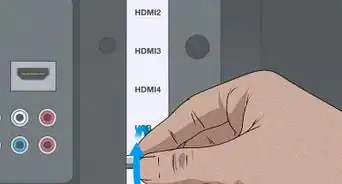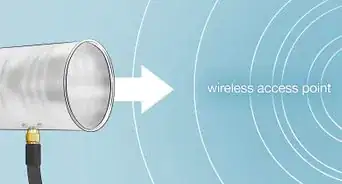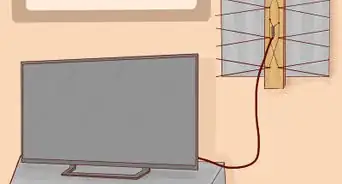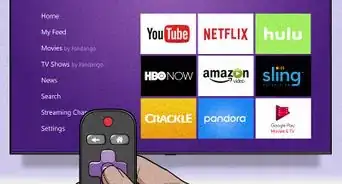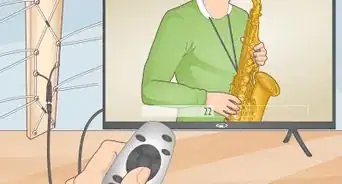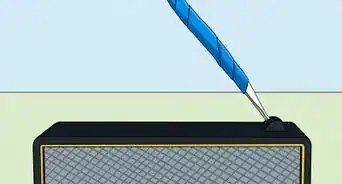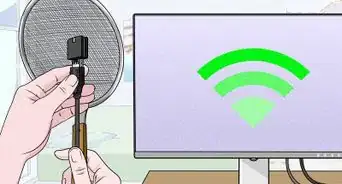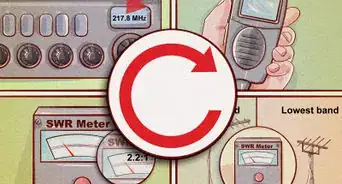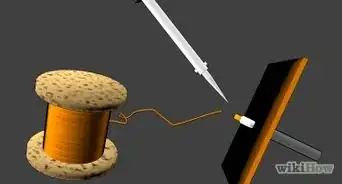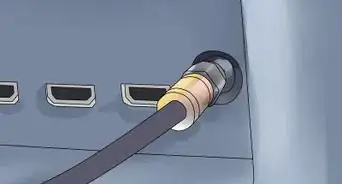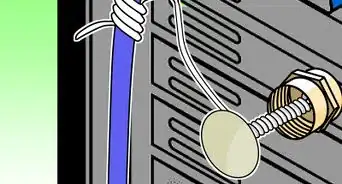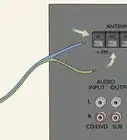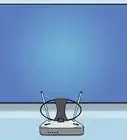This article was co-authored by wikiHow staff writer, Jack Lloyd. Jack Lloyd is a Technology Writer and Editor for wikiHow. He has over two years of experience writing and editing technology-related articles. He is technology enthusiast and an English teacher.
This article has been viewed 1,429,141 times.
Learn more...
This wikiHow teaches you how to create your own FM antenna in order to increase your FM receiver's range. Depending on your preferred range, you can do this by using either coaxial cable or speaker wire.
Steps
Using a Coaxial Cable
-
1Gather the necessary materials. In order to make a vertical antenna from a coaxial cable, you will need the following materials:[1]
- 50 ohm (or 75 ohm) coaxial wire with copper shielding
- FM receiver with a coaxial connector
- 3/8-inch copper tubing
- Wire cutters
- Hacksaw
- Soldering equipment
-
2Calculate the length of your antenna. This will determine both how much of the coaxial cable you have to strip and how long your copper tubing should be:
- Divide 468 by the frequency to which you want to connect (e.g., 468/108MHz would become 4.3).
- Divide the resulting number by 2 (e.g., 4.3/2 would become 2.15).
- Multiply the resulting number by 12 inches (30.5 cm) to find the antenna length (e.g., 2.15*12 inches would become 25.8 inches).
Advertisement -
3Cut off one end of the coaxial cable. While you'll want to leave one end of the coaxial cable intact in order for it to serve as the connector, the other end will need to be removed.
- You can use your wire cutters or a hacksaw to do this.
-
4Strip half of the antenna's overall length from the end of the coaxial cable. You'll need to remove each layer of shielding until you arrive at the white layer surrounding the coaxial cable itself.
- For example, if your antenna is supposed to be six inches per your calculations, you'll remove three inches of shielding.
- You'll need to remove the copper shielding during this process. The easiest way to do so is by making a shallow incision with the hacksaw all the way around the shielding and then attempting to strip it off from there.
-
5Cut the copper tubing to half of the antenna's overall length. The copper tubing will comprise the other half of your antenna's receiver, so it should be the same length as the section that you just stripped.
- Again, if you're using a six-inch antenna, the copper tubing will be three inches.
-
6Attach the tube to the coaxial cable. Slide the copper tubing onto the coaxial cable's stripped end, then slide it down to the
-
7Solder the coaxial cable's shielding to the tubing. You can do this by removing the PVC (black) shielding from around an inch of the coaxial cable directly below the unshielded part, peeling it back with a pair of pliers to form a lip, and then using your soldering pen to connect the lip to the copper tubing.
-
8Connect the coaxial cable to your audio receiver. The remaining coaxial connector should plug into the receiver's coaxial antenna port, which makes the rest of the antenna placement fairly simple.
-
9Place the antenna. Once the antenna is plugged in, angle it toward the nearest station and secure it in place if necessary.
- The fewer obstructions between your antenna and the nearest FM station, the stronger your signal will be.
- Your coaxial cable may be stiff enough to stand on its own without needing support, but you can use stables or any adhesive to prop up your antenna as needed.
Using Speaker Wire
-
1Understand when to use this method. If your connection to an FM station is mostly fine but requires some fine-tuning from time to time, you can use speaker wire as a quick range-extender to improve the quality of your connection.
- Speaker wire is not an ideal solution to long-range issues. If you're having trouble receiving a signal at all, you should try using coaxial cable instead.
-
2Gather the necessary materials. In order to craft a crude antenna from speaker wire, you'll need the following items:[2]
- 10 feet of speaker wire
- FM receiver with clamp-and-hold (or post) FM connections
- Wire strippers
-
3Split three feet of the speaker wire. Using a knife or a pair of pliers, separate the top three feet of the speaker wire tubes from each other. You should be left with three feet of spit wire and seven feet of intact wire.
-
4Arrange the speaker wire to form a "T" shape. You'll do this by bending each of the split wire ends at a 90-degree angle to the seven-foot section of wire.
-
5Strip the bottom two inches of insulation from the speaker wire. Use the wire strippers to do so. This will expose two bare wires at the bottom of the "T" shape.
-
6Find your receiver's antenna connections. These two connections will normally be marked "FM EXT" or "ANT EXT", but you'll almost always see "FM" somewhere near the connection; you should also see the word "Balanced" or "BAL" near the appropriate connections.
- FM receivers can have either clamp-and-hold connectors or post connectors. Clamp-and-hold connectors resemble literal clamps, while post connectors resemble knobs with exposed metal between them and the receiver itself.
-
7Connect the bottom of the "T" to the receiver. Use each of the exposed wires at the bottom of the "T" shape to connect to each of the FM connections.
- If there's only one FM connection, you can twist the two bare wires at the bottom of the "T" together to form one wire that can connect to the clamp or post.
-
8Place the antenna. Ideally, you'll place your antenna as high up and as close to the nearest station as possible. In some cases, this may mean threading your antenna along the top of a wall, or even running it outside.
- You may have to move the FM receiver in order to make this possible.
Community Q&A
Did you know you can get answers researched by wikiHow Staff?
Unlock staff-researched answers by supporting wikiHow
-
QuestionWhat is an FM dipole antenna?
 wikiHow Staff EditorThis answer was written by one of our trained team of researchers who validated it for accuracy and comprehensiveness.
wikiHow Staff EditorThis answer was written by one of our trained team of researchers who validated it for accuracy and comprehensiveness.
Staff Answer wikiHow Staff EditorStaff AnswerThe dipole antenna is a simple antenna consisting of two rods or wires of exactly the same type and length, which serve as the conductive elements for the electrical energy. The current is applied (transmitter) or taken (receiver) from between the two halves of the antenna. To help you get an image, just think of the "rabbit’s ears" used for broadcast television sets. You can find greater detail on how this antenna works in the Wikipedia article "Dipole antenna."
wikiHow Staff EditorStaff AnswerThe dipole antenna is a simple antenna consisting of two rods or wires of exactly the same type and length, which serve as the conductive elements for the electrical energy. The current is applied (transmitter) or taken (receiver) from between the two halves of the antenna. To help you get an image, just think of the "rabbit’s ears" used for broadcast television sets. You can find greater detail on how this antenna works in the Wikipedia article "Dipole antenna." -
QuestionCan I use a CB antenna for FM radio?
 wikiHow Staff EditorThis answer was written by one of our trained team of researchers who validated it for accuracy and comprehensiveness.
wikiHow Staff EditorThis answer was written by one of our trained team of researchers who validated it for accuracy and comprehensiveness.
Staff Answer wikiHow Staff EditorStaff AnswerIt is possible to use a CB antenna for FM radio. Some people like doing this to avoid having too many antennas or to keep things tidy in a vehicle or other place. It can be helpful to use a CB/FM splitter, that enables you to get the CB and FM reception. You can find instructions for using the CB antenna as an FM radio on various CB users’ forums online.
wikiHow Staff EditorStaff AnswerIt is possible to use a CB antenna for FM radio. Some people like doing this to avoid having too many antennas or to keep things tidy in a vehicle or other place. It can be helpful to use a CB/FM splitter, that enables you to get the CB and FM reception. You can find instructions for using the CB antenna as an FM radio on various CB users’ forums online. -
QuestionHow do FM antennas work?
 wikiHow Staff EditorThis answer was written by one of our trained team of researchers who validated it for accuracy and comprehensiveness.
wikiHow Staff EditorThis answer was written by one of our trained team of researchers who validated it for accuracy and comprehensiveness.
Staff Answer wikiHow Staff EditorStaff AnswerA transmitter FM antenna creates electrical signals or electrical energy and turns this energy into radio waves (electrons travel back and forth along the antenna, creating electromagnetic radiation). The electromagnetic radiation is better known as "radio waves" and these waves then travel long distances, carrying the sounds, songs, talk, etc. you’re familiar with on radio. A receiver antenna (on your radio, for example) captures the radio waves that have been transmitted, and the electric current generated is converted by your radio into the sounds you enjoy listening to. The bigger or more powerful the antennas, the farther the radio waves will travel.
wikiHow Staff EditorStaff AnswerA transmitter FM antenna creates electrical signals or electrical energy and turns this energy into radio waves (electrons travel back and forth along the antenna, creating electromagnetic radiation). The electromagnetic radiation is better known as "radio waves" and these waves then travel long distances, carrying the sounds, songs, talk, etc. you’re familiar with on radio. A receiver antenna (on your radio, for example) captures the radio waves that have been transmitted, and the electric current generated is converted by your radio into the sounds you enjoy listening to. The bigger or more powerful the antennas, the farther the radio waves will travel.
Warnings
- Antennae that are placed outdoors should have weatherproofing measures (e.g., waterproof coating) in place.⧼thumbs_response⧽
- If your antenna is placed outside, you should implement some form of lightning protection.⧼thumbs_response⧽
References
About This Article
To make an FM antenna using speaker wire, start by splitting 3 feet of wire and arranging it to form a “T” shape. Next, strip the bottom 2 inches of insulation from the wire. Then, connect the exposed wires at the bottom of the “T” shape to the FM connections. Finally, place your antenna as high up and as close to the nearest station as possible. To learn how to make an FM antenna using coaxial cable, keep reading!
